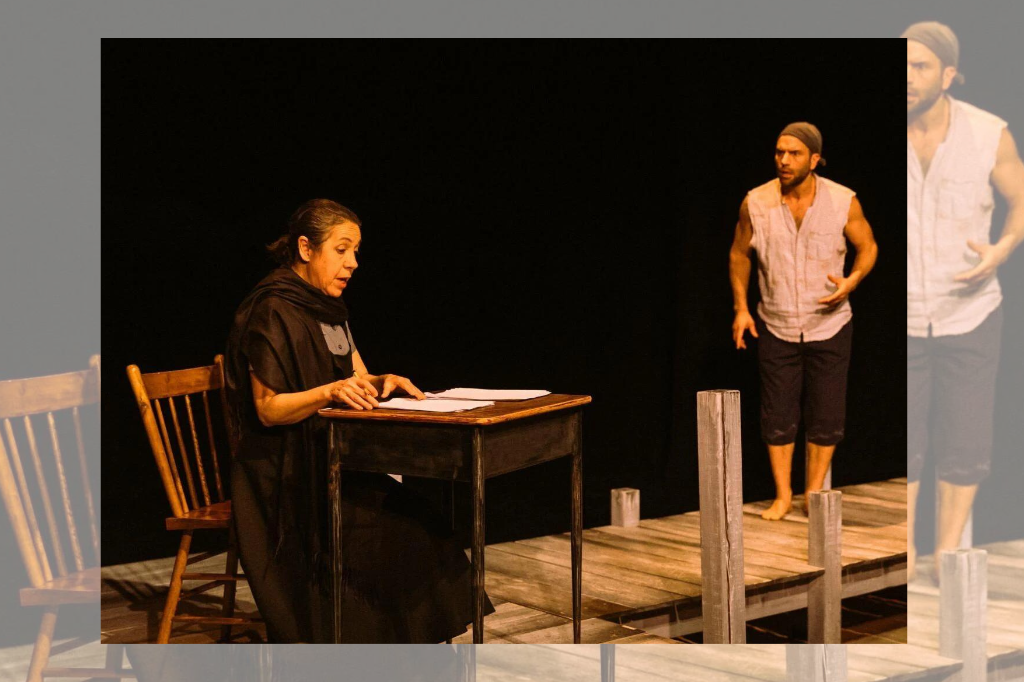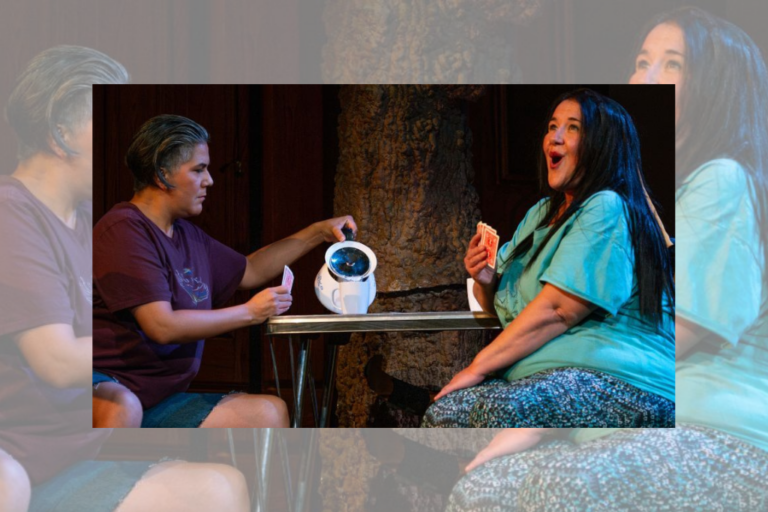REVIEW: On the Other Side of the Sea toys with human desires and fears
At first, you’re confused, and then you’re laughing, then suddenly, you’re having your very own existential crisis.
This February, Aluna Theatre presents the Canadian premiere of On the Other Side of the Sea by Salvadoran playwright Jorgelina Cerritos, winner of the prestigious Casa de las Américas Prize for drama. The play is surreal yet grounded, making the at times eccentric characters feel deeply relatable.
On the Other Side of the Sea centres on two characters with completely opposing lifestyles and aspirations, whose brief encounter changes their lives forever. Dorotea (Beatriz Pizano, also the artistic director of Aluna Theatre) is a rules-oriented civil servant. In her office, located right on the beach, she meets a man called Fisherman of the Sea (Carlos Gonzalez-Vio), who’s in search of identification papers so that he can marry, work, get an education, and adopt a dog. He’s aspirational, yet disorganized and unstructured.
Conversely, all Dorotea has is structure, in the form of a federal job, her own house, and a government-issued ID. Unlike the Fisherman, she has a “first name, last name, address, age,” and the power to give the Fisherman his dream life by legally granting him those four simple things. She also holds deep-seated regrets about not having anyone to share this life with, and perhaps some resentment towards the Fisherman’s potential to get everything he wants.
The play begins repetitively and under strange circumstances. Dorotea’s office is literally on the beach, just a desk right on the boardwalk. The Fisherman has gone his whole life without any legal identification, but suddenly it’s the one thing stopping him from pursuing an education, work, and personal life. When the Fisherman asks for legal help, Dorotea ignores him, waiting for clients who don’t show up, until ultimately, she’s back to the Fisherman. These scenes intercut with monologues about each character’s lives before arriving on this beach.
Despite being in constant opposition, the more these characters reveal about themselves, the more they relate to each other. The Fisherman is restricted by his inability to conform to the same societal norms that have bolstered Dorotea all her life. By showing the extremes of dreamer and realist tendencies, On the Other Side of the Sea holds a mirror to the audience’s own potential struggles with self-doubt.
The play’s initial repetitiveness led me to believe it would deal with existentialism from a strictly absurdist, sisyphean lens. However, the more I got to know the characters, the more I considered the real-life connotations of their situations. First, the arbitrariness of legal systems, with Dorotea refusing to help the Fisherman get his ID, simply because she might get in trouble. Then, the gendered implications, specifically through its portrayal of an older woman struggling with not having a family. The absurdity of the plot exposes the ridiculousness of these real-life systems and norms, and it made me question where my own aspirations might come from.
Although I am often wary of a translation’s ability to capture the rhythm and humour of its original text, this English-language version (translated by Margaret Stanton and Anna Donko) is funny, emotional, and packed with beautiful language. Even when no longer in Spanish, the text’s “Latinidad” is still engrained through the production’s portrayal of magical realism. There are many elements of On the Other Side of the Sea that are fantastical. However, when the characters accept that aesthetic as normal, the audience does, too.
Director Soheil Parsa’s minimalist staging helps further ground this magical realist story. The set consists of a chunk of boardwalk that spans the width of the stage, a janky desk and chair for Dorothea’s office, a large carpet beneath the boardwalk that resembles sand, and a wave painted on a backdrop. The costumes are of an ambiguous location and time period, but believably contemporary. The production design presents an elevated, dreamier reality that is as simple and strange as the story itself.
This quality carries over to all parts of the production. Thomas Ryder Payne’s sound design is consistently breathtaking and immersive, packed with intricate soundscapes that bring you into the magical world of this beach. It is most effective when combined with the lighting design to show time passing — the sound is overwhelming, and the lighting shows the time of day moving exceedingly fast, but it fits right in with the rest of the production. Slightly weird, but rooted in naturalism.
However, with the earlier lighting packed with these dynamic colours reminiscent of the sun setting and rising, I was disappointed in the occasionally excessive use of blackouts later on. Perhaps the intention was a gradual darkness into the night, but unfortunately its frequency caused a major dip in energy on the night I attended.
On the other hand, something I enjoyed more as the show went on were Pizano and Gonzalez-Vio’s performances. Their chemistry is great, their comedic timing is sharp, and the two actors keep you consistently engaged in their relationship. Both characters begin quite stubborn and narrow-sighted, but their greatest opposition turns out to be their unwillingness to express their desires. Gonzalez-Vio does not hold back when expressing the Fisherman’s love for his girlfriend, his friend, and his dog, making it increasingly easy to root for him. Pizano is stoic and unrelenting throughout, which makes Dorotea’s eventual outpour of regret incredibly heartbreaking.
The plot is simple, but the characters experience the extremes of human desires, fears, and regrets, in a journey sure to resonate with anyone.
On the Other Side of the Sea runs at The Theatre Centre until February 25. Tickets are available here.
Intermission reviews are independent and unrelated to Intermission’s partnered content. Learn more about Intermission’s partnership model here.












Comments